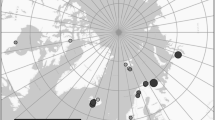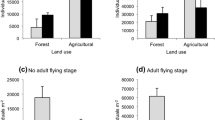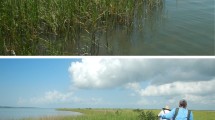Abstract
The aim of this study was to test the effects of agricultural land use on benthic insect population body-mass and community biomass size spectrum. Agricultural land use effects were assessed by conducting a reciprocal transfer experiment between two stream reaches exposed to differing intensities of row crop and livestock agricultural activity representing best attainable and highly developed agricultural land use scenarios. We found that transferred insect communities showed no change in richness, abundance, distribution or biomass, indicating that exposure to increased agricultural intensity did not have selective lethal effects on transferred benthic insect communities. However, populations of Ephemerellidae and Hydropsyche demonstrated an increase and decrease, respectively, in body-mass following the transfer to the best attainable agriculture site. Furthermore, the community biomass size spectrum at the best attainable agriculture site contained large, predatory insects not found at the intensive agriculture site. Our findings suggest that taxon-specific body-mass and biomass size spectra have the potential to detect environmental effects prior to long-term community changes. Further research is needed to explore the mechanisms by which changes in the biomass size spectrum link agricultural intensity to shifts in benthic insect community structure.




Similar content being viewed by others

References
Allan, J. D., 2004. Landscapes and riverscapes: the influence of land use on stream ecosystems. Annual Review of Ecology Evolution and Systematics 35: 257–284.
Anderson, M. & C. T. Braak, 2003. Permutation tests for multi-factorial analysis of variance. Journal of Statistical Computation and Simulation 73: 85–113.
Barnes, C., D. Maxwell, D. C. Reuman & S. Jennings, 2010. Global patterns in predator—prey size relationships reveal size dependency of trophic transfer efficiency. Ecology 91: 222–232.
Basset, A., F. Sangiorgio & M. Pinna, 2004. Monitoring with benthic macroinvertebrates: advantages and disadvantages of body size descriptors. Aquatic Conservation 14: S43–S58.
Belovsky, G. E., 1997. Optimal foraging and community structure: the allometry of herbivore food selection and competition. Evolutionary Ecology 11: 641–672.
Benke, A. C., A. D. Huryn, L. A. Smock & J. B. Wallace, 1999. Length-mass relationships for freshwater macroinvertebrates in North America with particular reference to the southeastern United States. Journal of the North American Benthological Society 18: 308–343.
Benstead, J. P. & C. M. Pringle, 2004. Deforestation alters the resource base and biomass of endemic stream insects in eastern Madagascar. Freshwater Biology 49: 490–501.
Blanchard, J., N. Dulvy, S. Jennings, J. Ellis, J. Pinnegar, A. Tidd & L. Kell, 2005. Do climate and fishing influence size-based indicators of Celtic Sea fish community structure? ICES Journal of Marine Science 62: 405–411.
Blann, K. L., J. L. Anderson, G. R. Sands & B. Vondracek, 2009. Effects of agricultural drainage on aquatic ecosystems: a review. Critical Reviews in Environmental Science and Technology 39: 909–1001.
Bonada, N., N. Prat, V. H. Resh & B. Statzner, 2006. Developments in aquatic insect biomonitoring: a comparative analysis of recent approaches. Annual Review of Entomology 51: 495–523.
Bourassa, N. & A. Cattaneo, 1998. Control of periphyton biomass in Laurentian streams (Québec). Journal of the North American Benthological Society 17: 420–429.
Brose, U., J. A. Dunne, J. M. Montoya, O. L. Petchey, F. D. Schneider & U. Jacob, 2012. Climate change in size-structured ecosystems. Philosophical Transactions of the Royal Society B 367: 2903–2912.
Brown, J. H., J. F. Gillooly, A. P. Allen, V. M. Savage & G. B. West, 2004. Toward a metabolic theory of ecology. Ecology 85: 1771–1789.
Buendia, C., C. N. Gibbins, D. Vericat, R. J. Batalla & A. Douglas, 2013. Detecting the structural and functional impacts of fine sediment on stream invertebrates. Ecological Indicators 25: 184–196.
Cardillo, M., 2003. Biological determinants of extinction risk: why are smaller species less vulnerable? Animal Conservation Forum 6: 63–69.
Carlisle, D. M. & C. P. Hawkins, 2008. Land use and the structure of western US stream invertebrate assemblages: predictive models and ecological traits. Journal of the North American Benthological Society 27: 986–999.
Cashman, M. J., J. D. Wehr & K. Truhn, 2013. Elevated light and nutrients alter the nutritional quality of stream periphyton. Freshwater Biology 58: 1447–1457.
Cohen, J. E., T. Jonsson & S. R. Carpenter, 2003. Ecological community description using the food web, species abundance, and body size. Proceedings of the National Academy of Sciences of the United States of America 100: 1781–1786.
Dale, V. H. & S. C. Beyeler, 2001. Challenges in the development and use of ecological indicators. Ecological Indicators 1: 3–10.
Dossena, M., G. Yvon-Durocher, J. Grey, J. M. Montoya, D. M. Perkins, M. Trimmer & G. Woodward, 2012. Warming alters community size structure and ecosystem functioning. Proceedings of the Royal Society B 279: 3011–3019.
Edwards, A. M., J. P. W. Robinson, M. J. Plank, J. K. Baum & J. L. Blanchard, 2017. Testing and recommending methods for fitting size spectra to data. Methods in Ecology and Evolution 8: 57–67.
ESRI, 2013. ArcGIS Version 10. Environment Systems Research Institute Inc., Redlands, CA.
Fleeger, J. W., K. R. Carman & R. M. Nisbet, 2003. Indirect effects of contaminants in aquatic ecosystems. Science of The Total Environment 317: 207–233.
Grimstead, J. P., E. M. Krynak & A. G. Yates, 2018. Scale-specific land cover thresholds for conservation of stream invertebrate communities in agricultural landscapes. Landscape Ecology 33: 2239–2252.
Harding, J. S., R. G. Young, J. W. Hayes, K. A. Shearer & J. D. Stark, 1999. Changes in agricultural intensity and river health along a river continuum. Freshwater Biology 42: 345–357.
Hildrew, A. G., D. G. Raffaelli & R. Edmonds-Brown, 2007. Body size: the structure and function of aquatic ecosystems. Cambridge University Press, Cambridge.
Hladyz, S., K. Abjornsson, E. Chauvet, M. Dobson, A. Elosegi, V. Ferreira, T. Fleituch, M. O. Gessner, P. S. Giller, V. Gulis, S. A. Hutton, J. O. Lacoursiere, S. Lamothe, A. Lecerf, B. Malmqvist, B. G. McKie, M. Nistorescu, E. Preda, M. P. Riipinen, G. Risnoveanu, M. Schindler, S. D. Tiegs, L. B.-M. Vought & G. Woodward, 2011. Stream ecosystem functioning in an agricultural landscape: the importance of terrestrial-aquatic linkages. In Woodward, G. (ed), Advances in Ecological Research, Vol. 44. Elsevier Academic Press Inc., San Diego: 211–276.
Hocking, M. D., N. K. Dulvy, J. D. Reynolds, R. A. Ring & T. E. Reimchen, 2013. Salmon subsidize an escape from a size spectrum. Proceedings of the Royal Society B 280: 20122433.
Holm, S., 1979. A simple sequentially rejective multiple test procedure. Scandinavian Journal of Statistics 6: 65–70.
Honěk, A., 1993. Intraspecific variation in body size and fecundity in insects: a general relationship. Oikos 66: 483–492.
Hooper, H., R. Sibly, T. Hutchinson & S. Maund, 2003. The influence of larval density, food availability and habitat longevity on the life history and population growth rate of the midge Chironomus riparius. Oikos 102: 515–524.
Jennings, S., J. K. Pinnegar, N. V. C. Polunin & T. W. Boon, 2001. Weak cross-species relationships between body size and trophic level belie powerful size-based trophic structuring in fish communities. Journal of Animal Ecology 70: 934–944.
Johnson, R. K., D. Hering, M. T. Furse & P. F. M. Verdonschot, 2006. Indicators of ecological change: comparison of the early response of four organism groups to stress gradients. Hydrobiologia 566: 139–152.
Jonsson, M. & K. Stenroth, 2016. True autochthony and allochthony in aquatic–terrestrial resource fluxes along a landuse gradient. Freshwater Science 35: 882–894.
Karr, J. R., 1999. Defining and measuring river health. Freshwater biology 41: 221–234.
Krynak, E. M. & A. G. Yates, 2018. Benthic invertebrate taxonomic and trait associations with land use in an intensively managed watershed: implications for indicator identification. Ecological Indicators 93: 1050–1059.
Lange, K., C. R. Townsend & C. D. Matthaei, 2014. Can biological traits of stream invertebrates help disentangle the effects of multiple stressors in an agricultural catchment? Freshwater Biology 59: 2431–2446.
Larsen, S. & S. J. Ormerod, 2010. Combined effects of habitat modification on trait composition and species nestedness in river invertebrates. Biological Conservation 143: 2638–2646.
Larsen, T. H., N. M. Williams & C. Kremen, 2005. Extinction order and altered community structure rapidly disrupt ecosystem functioning. Ecology Letters 8: 538–547.
Lavoie, I., J. Lento & A. Morin, 2010. Inadequacy of size distributions of stream benthic diatoms for environmental monitoring. Journal of the North American Benthological Society 29: 586–601.
Mander, Ü., Y. Hayakawa & V. Kuusemets, 2005. Purification processes, ecological functions, planning and design of riparian buffer zones in agricultural watersheds. Ecological Engineering 24: 421–432.
Martínez, A., A. Larrañaga, A. Miguélez, G. Yvon-Durocher & J. Pozo, 2016. Land use change affects macroinvertebrate community size spectrum in streams: the case of Pinus radiata plantations. Freshwater Biology 61: 69–79.
Matthaei, C. D., J. J. Piggott & C. R. Townsend, 2010. Multiple stressors in agricultural streams: interactions among sediment addition, nutrient enrichment and water abstraction: sediment, nutrients & water abstraction. Journal of Applied Ecology 47: 639–649.
McKinney, M. L., 1997. Extinction vulnerability and selectivity: combining ecological and paleontological views. Annual Review of Ecology and Systematics 28: 495–516.
Mewhort, D. J. K., M. Kelly & B. T. Johns, 2009. Randomization tests and the unequal-N/unequal-variance problem. Behavior Research Methods 41: 664–667.
Montoya, J. M., S. L. Pimm & R. V. Solé, 2006. Ecological networks and their fragility. Nature 442: 259–264.
Morin, A., N. Bourassa & A. Cattaneo, 2001. Use of size spectra and empirical models to evaluate trophic relationships in streams. Limnology and Oceanography 46: 935–940.
Morin, A., J. Stephenson, J. Strike & A. G. Solimini, 2004. Sieve retention probabilities of stream benthic invertebrates. Journal of the North American Benthological Society 23: 383–391.
Norris, R. H. & C. P. Hawkins, 2000. Monitoring river health. Hydrobiologia 435: 5–17.
Ontario Ministry of Natural Resources, 2008. Southern Ontario Land Resource Information System (SOLRIS) Land Use Data. Ontario Ministry of Natural Resources, Toronto, ON.
Osborne, L. L. & D. A. Kovacic, 1993. Riparian vegetated buffer strips in water-quality restoration and stream management. Freshwater Biology 29: 243–258.
Pauly, D., V. Christensen, J. Dalsgaard, R. Froese & F. Torres, 1998. Fishing down marine food webs. Science 279: 860–863.
Peckarsky, B. L., C. A. Cowan, M. A. Penton & C. Anderson, 1993. Sublethal consequences of stream-dwelling predatory stoneflies on mayfly growth and fecundity. Ecology 74: 1836–1846.
Peckarsky, B. L., B. W. Taylor, A. R. McIntosh, M. A. McPeek & D. A. Lytle, 2001. Variation in mayfly size at metamorphosis as a developmental response to risk of predation. Ecology 82: 740–757.
Pedley, S. M. & P. M. Dolman, 2014. Multi-taxa trait and functional responses to physical disturbance. Journal of Animal Ecology 83: 1542–1552.
Petchey, O. L. & A. Belgrano, 2010. Body-size distributions and size-spectra: universal indicators of ecological status? Biology Letters 6: 434–437.
Piggott, J. J., C. R. Townsend & C. D. Matthaei, 2015. Climate warming and agricultural stressors interact to determine stream macroinvertebrate community dynamics. Global Change Biology 21: 1887–1906.
Project Team, Water Management Plan, 2014. Grand River Watershed Water Management Plan. Grand River Conservation Authority, Cambridge, ON.
Quinn, J. M. & C. W. Hickey, 1990. Magnitude of effects of substrate particle size, recent flooding, and catchment development on benthic invertebrates in 88 New Zealand rivers. New Zealand Journal of Marine and Freshwater Research 24: 411–427.
R Core Team, 2016. R: a language and environment for statistical computing. R Foundation for Statistical Computing, Vienna. https://www.R-project.org/.
Reizopoulou, S. & A. Nicolaidou, 2007. Index of size distribution (ISD): a method of quality assessment for coastal lagoons. Hydrobiologia 577: 141–149.
Richards, C., G. E. Host & J. W. Arthur, 1993. Identification of predominant environmental factors structuring stream macroinvertebrate communities within a large agricultural catchment. Freshwater Biology 29: 285–294.
Rosario-Martinez, H. D., 2015. phia: post hoc interaction analysis. R package version 0.2-1. https://CRAN.R-project.org/package=phia.
Schneider, C. A., W. S. Rasband & K. W. Eliceiri, 2012. NIH Image to ImageJ: 25 years of image analysis. Nature Methods 9: 671–675.
Scrimgeour, G. & J. Culp, 1994. Feeding while evading predators by a lotic mayfly-linking short-term foraging behaviors to long-term fitness consequences. Oecologia 100: 128–134.
Solan, M., B. J. Cardinale, A. L. Downing, K. A. M. Engelhardt, J. L. Ruesink & D. S. Srivastava, 2004. Extinction and ecosystem function in the marine benthos. Science 306: 1177–1180.
Stenroth, K., L. E. Polvi, E. Fältström & M. Jonsson, 2015. Land-use effects on terrestrial consumers through changed size structure of aquatic insects. Freshwater Biology 60: 136–149.
Stoddard, J. L., D. P. Larsen, C. P. Hawkins, R. K. Johnson & R. H. Norris, 2006. Setting expectations for the ecological condition of streams: the concept of reference condition. Ecological Applications 16: 1267–1276.
Townsend, C. R., M. R. Scarsbrook & S. Dolédec, 1997. The intermediate disturbance hypothesis, refugia, and biodiversity in streams. Limnology and Oceanography 42: 938–949.
Trebilco, R., J. K. Baum, A. K. Salomon & N. K. Dulvy, 2013. Ecosystem ecology: size-based constraints on the pyramids of life. Trends in Ecology & Evolution 28: 423–431.
U.S. Environmental Protection Agency, 2012. Freshwater traits database (final report). U.S. Environmental Protection Agency, Washington, DC.
U.S. Environmental Protection Agency, 2015. North American Ecoregions-Level I. U.S. EPA Office of Research & Development (ORD)-National Health and Environmental Effects Research Laboratory (NHEERL).
Utz, R. M., R. H. Hilderbrand & D. M. Boward, 2009. Identifying regional differences in threshold responses of aquatic invertebrates to land cover gradients. Ecological Indicators 9: 556–567.
Wagenhoff, A., C. R. Townsend & C. D. Matthaei, 2012. Macroinvertebrate responses along broad stressor gradients of deposited fine sediment and dissolved nutrients: a stream mesocosm experiment. Journal of Applied Ecology 49: 892–902.
Waite, I., 2014. Agricultural disturbance response models for invertebrate and algal metrics from streams at two spatial scales within the U.S. Hydrobiologia 726: 285–303.
Wang, L., J. Lyons & P. Kanehl, 2002. Effects of watershed best management practices on habitat and fish in wisconsin streams1. JAWRA Journal of the American Water Resources Association 38: 663–680.
Wentworth, C. K., 1922. A scale of grade and class terms for clastic sediments. The Journal of Geology 30: 377–392.
Wheeler, B. & M. Torchiano, 2016. lmPerm: Permutation tests for linear models. R package version 2.1.0. https://CRAN.R-project.org/package=lmPerm.
Wheeler, R. E., 2010. Permutation tests for linear models in R. The Comprehensive R Archive Network 1: 1–2.
White, E. P., S. K. M. Ernest, A. J. Kerkhoff & B. J. Enquist, 2007. Relationships between body size and abundance in ecology. Trends in Ecology & Evolution 22: 323–330.
Woodward, G., B. Ebenman, M. Emmerson, J. M. Montoya, J. M. Olesen, A. Valido & P. H. Warren, 2005. Body size in ecological networks. Trends in Ecology & Evolution 20: 402–409.
Yates, A. G. & R. C. Bailey, 2010. Improving the description of human activities potentially affecting rural stream ecosystems. Landscape Ecology 25: 371–382.
Yates, A. G., R. B. Brua, J. M. Culp, P. A. Chambers & L. I. Wassenaar, 2014. Sensitivity of structural and functional indicators depends on type and resolution of anthropogenic activities. Ecological Indicators 45: 274–284.
Zavaleta, E., J. Pasari, J. Moore, D. Hernández, K. B. Suttle & C. C. Wilmers, 2009. Ecosystem responses to community disassembly. Annals of the New York Academy of Sciences 1162: 311–333.
Acknowledgements
This work was supported by grants to A.G. Yates from the Canadian Water Network (4000) and the Natural Sciences and Engineering Research Council of Canada (RGPIN/435371-2013). Additional support for this project was supplied through scholarships to E. M. Krynak provided by the Ontario Trillium Foundation, and Western University. We would like to thank Jen Lento for advice concerning biomass size spectra analysis, Bob Brua for advice and discussions regarding rock basket design, and all the members of the StrEAMS lab for laboratory and field assistance, especially, Jeremy Grimstead, Shirley Ngai, Erika Hill, Renee Lazor, Laura Briggs, and Ben Wilcox.
Author information
Authors and Affiliations
Corresponding author
Additional information
Handling editor: Marcelo S. Moretti
Publisher's Note
Springer Nature remains neutral with regard to jurisdictional claims in published maps and institutional affiliations.
Electronic supplementary material
Below is the link to the electronic supplementary material.
Rights and permissions
About this article
Cite this article
Krynak, E.M., Yates, A.G. Intensive agriculture alters the biomass size spectrum and body-mass of benthic insects: evidence from a reciprocal transfer experiment. Hydrobiologia 847, 1221–1235 (2020). https://doi.org/10.1007/s10750-020-04178-1
Received:
Revised:
Accepted:
Published:
Issue Date:
DOI: https://doi.org/10.1007/s10750-020-04178-1



